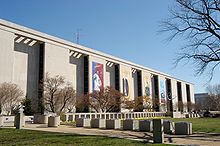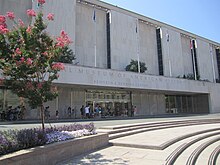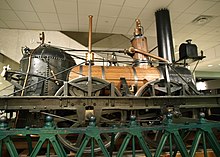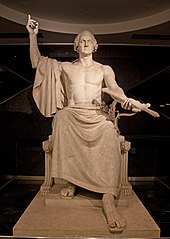
The Smithsonian Institution, or simply the Smithsonian, is a group of museums, education and research centers, the largest such complex in the world, created by the U.S. government "for the increase and diffusion of knowledge". Founded on August 10, 1846, it operates as a trust instrumentality and is not formally a part of any of the three branches of the federal government. The institution is named after its founding donor, British scientist James Smithson. It was originally organized as the United States National Museum, but that name ceased to exist administratively in 1967.
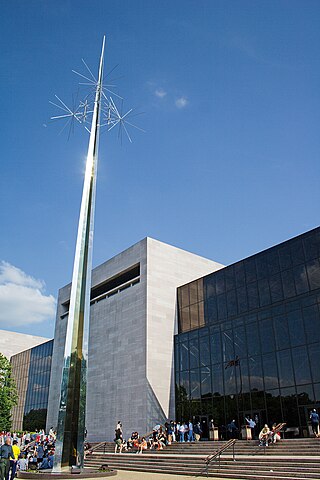
The National Air and Space Museum of the Smithsonian Institution, is a museum in Washington, D.C., in the United States dedicated to human flight and space exploration.

The National Gallery of Art, and its attached Sculpture Garden, is a national art museum in Washington, D.C., United States, located on the National Mall, between 3rd and 9th Streets, at Constitution Avenue NW. Open to the public and free of charge, the museum was privately established in 1937 for the American people by a joint resolution of the United States Congress. Andrew W. Mellon donated a substantial art collection and funds for construction. The core collection includes major works of art donated by Paul Mellon, Ailsa Mellon Bruce, Lessing J. Rosenwald, Samuel Henry Kress, Rush Harrison Kress, Peter Arrell Browne Widener, Joseph E. Widener, and Chester Dale. The Gallery's collection of paintings, drawings, prints, photographs, sculpture, medals, and decorative arts traces the development of Western art from the Middle Ages to the present, including the only painting by Leonardo da Vinci in the Americas and the largest mobile created by Alexander Calder.

The Anacostia Community Museum is a community museum in the Anacostia neighborhood of Washington, D.C., in the United States. It is one of twenty museums under the umbrella of the Smithsonian Institution and was the first federally funded community museum in the United States. The museum, founded in 1967, was created with the intention to bring aspects of the Smithsonian museums, located on the National Mall, to the Anacostia neighborhood, with the hope that community members from the neighborhood would visit the main Smithsonian museums. It became federally funded in 1970 and focuses on the community in and around Anacostia in its exhibitions. This museum also houses a library.

The Brooklyn Museum is an art museum located in the New York City borough of Brooklyn. At 560,000 square feet (52,000 m2), the museum is New York City's second largest and contains an art collection with around 500,000 objects. Located near the Prospect Heights, Crown Heights, Flatbush, and Park Slope neighborhoods of Brooklyn, the museum's Beaux-Arts building was designed by McKim, Mead & White.

The Smithsonian Institution Building, more commonly known as the Smithsonian Castle or simply The Castle, is a building on the National Mall housing the Smithsonian Institution's administrative offices and information center. Built as the first Smithsonian museum building, it is constructed of Seneca red sandstone in the Norman Revival style. It was completed in 1855 and designated a National Historic Landmark in 1965.

The National Museum of Natural History is a natural history museum administered by the Smithsonian Institution, located on the National Mall in Washington, D.C., United States. It has free admission and is open 364 days a year. In 2022, with 3.9 million visitors, it was the most-visited museum in the United States.

The Hirshhorn Museum and Sculpture Garden is an art museum beside the National Mall in Washington, D.C., United States. The museum was initially endowed during the 1960s with the permanent art collection of Joseph H. Hirshhorn. It was designed by architect Gordon Bunshaft and is part of the Smithsonian Institution. It was conceived as the United States' museum of contemporary and modern art and currently focuses its collection-building and exhibition-planning mainly on the post–World War II period, with particular emphasis on art made during the last 50 years.

The Steven F. Udvar-Hazy Center, also called the Udvar-Hazy Center, is the Smithsonian National Air and Space Museum (NASM)'s annex at Washington Dulles International Airport in the Chantilly area of Fairfax County, Virginia. It holds numerous exhibits, including the Space Shuttle Discovery, the Enola Gay, and the Boeing 367-80, the main prototype for the popular Boeing 707 airliner.

The Arts and Industries Building is the second oldest of the Smithsonian museums on the National Mall in Washington, D.C. Initially named the National Museum, it was built to provide the Smithsonian with its first proper facility for public display of its growing collections. The building, designed by architects Adolf Cluss and Paul Schulze, opened in 1881, hosting an inaugural ball for President James A. Garfield. It was designated a National Historic Landmark in 1971. After being closed since 2004 for repair and renovation, the building reopened in 2021 with a special exhibition, Futures.

The National Museum of the American Indian–New York, the George Gustav Heye Center, is a branch of the National Museum of the American Indian at the Alexander Hamilton U.S. Custom House in Manhattan, New York City. The museum is part of the Smithsonian Institution. The center features contemporary and historical exhibits of art and artifacts by and about Native Americans.

Cooper Hewitt, Smithsonian Design Museum is a design museum housed within the Andrew Carnegie Mansion in Manhattan, New York City, along the Upper East Side's Museum Mile. It is one of 19 museums that operate within the Smithsonian Institution and is one of three Smithsonian facilities located in New York City, the other two being the National Museum of the American Indian's George Gustav Heye Center in Bowling Green and the Archives of American Art New York Research Center in the Flatiron District. Unlike other Smithsonian museums, Cooper Hewitt is not free to the public and charges an admissions fee to visitors. It is the only museum in the United States devoted to historical and contemporary design. Its collections and exhibitions explore approximately 240 years of design aesthetic and creativity.

The Smithsonian American Art Museum is a museum in Washington, D.C., part of the Smithsonian Institution. Together with its branch museum, the Renwick Gallery, SAAM holds one of the world's largest and most inclusive collections of art, from the colonial period to the present, made in the United States. The museum has more than 7,000 artists represented in the collection. Most exhibitions take place in the museum's main building, the Old Patent Office Building, while craft-focused exhibitions are shown in the Renwick Gallery.

The National Museum of African Art is the Smithsonian Institution's African art museum, located on the National Mall of the United States capital. Its collections include 9,000 works of traditional and contemporary African art from both Sub-Saharan and North Africa, 300,000 photographs, and 50,000 library volumes. It was the first institution dedicated to African art in the United States and remains the largest collection. The Washington Post called the museum a mainstay in the international art world and the main venue for contemporary African art in the United States.

The California Science Center is a state agency and museum located in Exposition Park, Los Angeles, next to the Natural History Museum of Los Angeles County and the University of Southern California. Billed as the West Coast's largest hands-on science center, the California Science Center is a public-private partnership between the State of California and the California Science Center Foundation. The California Natural Resources Agency oversees the California Science Center and the California African American Museum. Founded in 1951 as the "California Museum of Science and Industry", the Museum was remodeled and renamed in 1998 as the "California Science Center". The California Science Center hosts the California State Science Fair annually.

The Renwick Gallery is a branch of the Smithsonian American Art Museum located in Washington, D.C. that displays American craft and decorative arts from the 19th to 21st century. The gallery is housed in a National Historic Landmark building that was opened in 1859 on Pennsylvania Avenue and originally housed the Corcoran Gallery of Art. When it was built in 1859, it was known as "the American Louvre".
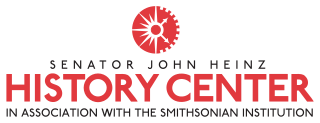
The Senator John Heinz History Center, an affiliate of the Smithsonian Institution, is the largest history museum in the Commonwealth of Pennsylvania, United States. Named after U.S. Senator H. John Heinz III (1938–1991) from Pennsylvania, it is located in the Strip District of Pittsburgh.
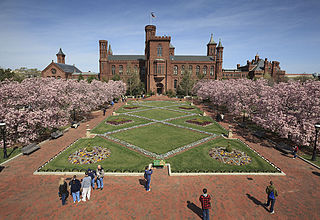
The Smithsonian Gardens, a division of the Smithsonian Institution, is responsible for the "landscapes, interiorscapes, and horticulture-related collections and exhibits", which serve as an outdoor extension of the Smithsonian's museums and learning spaces in Washington, D.C. Established in 1972 as a groundskeeping and horticulture program, Smithsonian Gardens currently manages 180 acres of gardens on the National Mall, 64,000 square feet of greenhouse production space, and the Archives of American Gardens, a research collection of over 60,000 photographs and archival records covering American landscape history from the 1870s to the present.
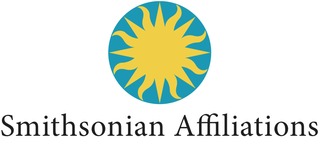
Smithsonian Affiliations is a division of the Smithsonian Institution that establishes long-term partnerships with non-Smithsonian museums and educational and cultural organizations in order to share collections, exhibitions and educational strategies and conduct joint research. Partner organizations are known as "Smithsonian Affiliates".


